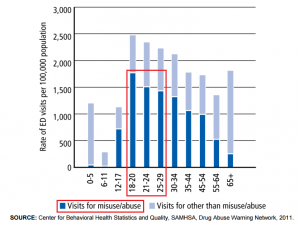by Jason Anderson
As a fourth-year student practicing in the pharmacy, I see the face of addiction every week. The signs of drug addiction are no longer presented as shady drug deals in a dark alley but are now disguised as early refill requests for opioid pain medication and stimulant ADHD medications. The description of the stereotypical drug abuser has changed drastically over the last few years. For example, the highest rate of emergency department visits in 2011 related to drug misuse or abuse was between the age range 18-29. This, coincidentally, is the demographic of the college population. Fifty-one percent of these cases involved non-medical use of pharmaceuticals. The real question is this: how do we overcome these biological changes of addiction to alter prescription drug misuse behaviors?
In order the overcome the biological and physical changes associated with addiction, we need to change how we address prescription drug misuse. It is imperative to incorporate innovative ways to change college students’ behaviors. Before we are able to change their behaviors, we need to first change their perceptions regarding prescription drug misuse. Let’s examine an example of prescription stimulant use without a medical indication such as ADHD. In a study conducted by Lookatch et. al in 2014, the researchers found that non-medical use of stimulants for “studying purposes” was perceived as more acceptable by college students than the need “to get high.” This generally accepted, albeit irrational, thought process, validates prescription drug misuse in the minds of college students because the anticipated outcome of higher grades can positively impact their academic achievements. Changing these deeply rooted perceptions is the first step required to reverse the ingrained behaviors of college students towards prescription drug misuse.
Let’s continue our example of prescription stimulant misuse and look at innovative ways to change behaviors long term. Since prescription drug misuse is a growing problem on college campuses, we will need to attack the issue from multiple angles. One strategy, which is currently used at Miami University in Ohio, involves minimizing abuse by maximizing care. All students who seek medication for ADHD must first attend a “brain boosting” workshop. In this workshop, students are taught integral attention skills such as time management, distraction minimization and procrastination reduction. In addition to this workshop, prescribing of medication for ADHD is addressed in a step-wise function. Students are first prescribed medications without addictive potential, such as Strattera® (atomoxetine). This reduces the exposure of the college population to stimulant ADHD medications. In addition to maximizing care, we could also add in social media or universal text messages to engage the entire student body. These text messages would be sent around the time frame when student would be most at risk for abusing prescription stimulants, such as finals week. While text messaging alone has not been shown to be effective in changing student behavior (Quanbeck et al., 2014), this strategy, when used in combination with other methods to combat prescription drug abuse, might be beneficial. Lastly, attention must be focused on preventing the diversion of prescription medications. This could be achieved by educating those with prescription medications about the dangers of theft and the consequences of sharing prescription medications. Providing students with a lockbox for their medications is one proposed strategy for reducing theft.
As the face of addiction changes, we have to change the way prescription drug misuse on the college campus is addressed. We need to develop and implement novel ways to alter behavior. These innovative methods could include maximizing non-pharmacological care, engaging students via text messaging or social media and decreasing diversion with lockboxes. Prescription drugs have the ability to make a drastic medical impact on those who truly need the medication but also deter bright college students, who are the creators of our future, from obtaining their highest potential. The age range of emergency department visits is a gloomy statistic. However, it also holds potential for us to make a drastic impact via innovative interventions that will help change the face of addiction for future generations.
References
Lookatch SJ, Moore TM, Katz EC. Effects of gender and motivations on perceptions of nonmedical use of prescription stimulants. J Am Coll Health. 2014;62(4):255-262. doi:10.1080/07448481.2014.891593.
Substance Abuse and Mental Health Services Administration, Drug Abuse Warning Network, 2011: National Estimates of Drug-Related Emergency Department Visits. HHS Publication No. (SMA) 13-4760, DAWN Series D-39. Rockville, MD: Substance Abuse and Mental Health Services Administration, 2013.
Quanbeck A, Chih M-Y, Isham A, Johnson R, Gustafson D. Mobile Delivery of Treatment for Alcohol Use Disorders. Alcohol Res. 2014;36(1):111-122.
 Jason Anderson is currently a fourth-year student in the PharmD/PhD program at The Ohio State University College of Pharmacy. For his PhD, Jason works on a National Institute of Health research project at OSU regarding inhibitors of HIV integrase. He spent the month of November doing an Advanced Pharmacy Practice Experience rotation at the Center of Science and Industry (COSI) in Columbus, Ohio, teaching the museum visitors about prescription drug safety.
Jason Anderson is currently a fourth-year student in the PharmD/PhD program at The Ohio State University College of Pharmacy. For his PhD, Jason works on a National Institute of Health research project at OSU regarding inhibitors of HIV integrase. He spent the month of November doing an Advanced Pharmacy Practice Experience rotation at the Center of Science and Industry (COSI) in Columbus, Ohio, teaching the museum visitors about prescription drug safety.
